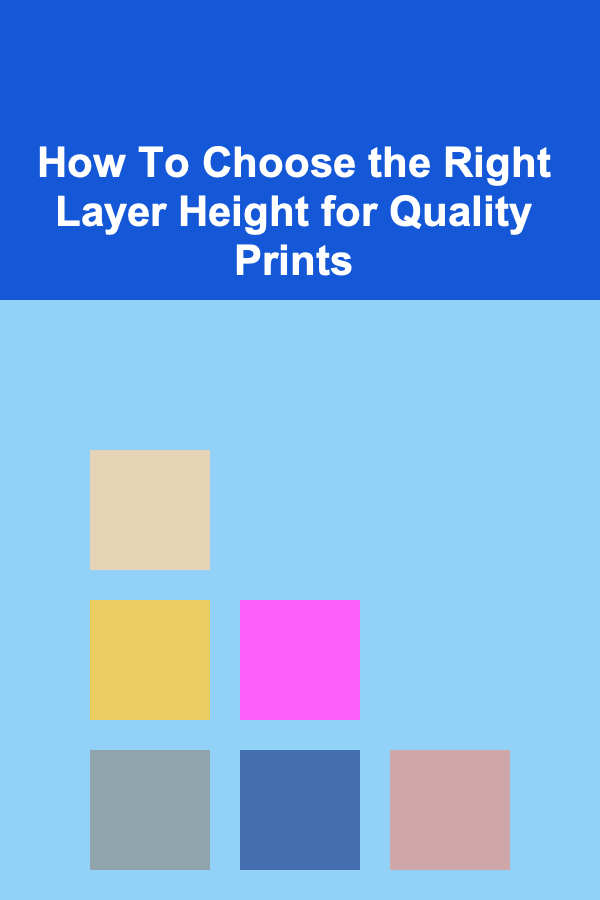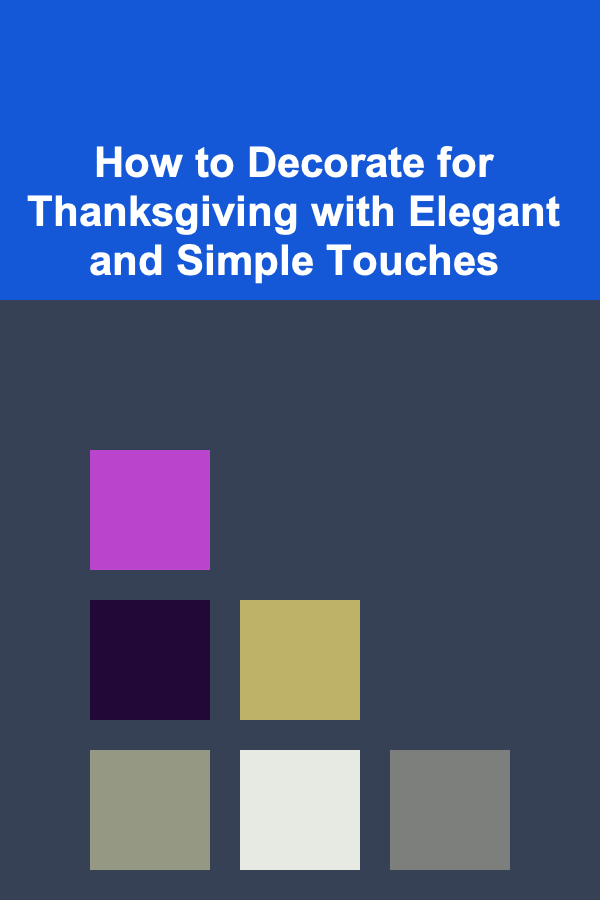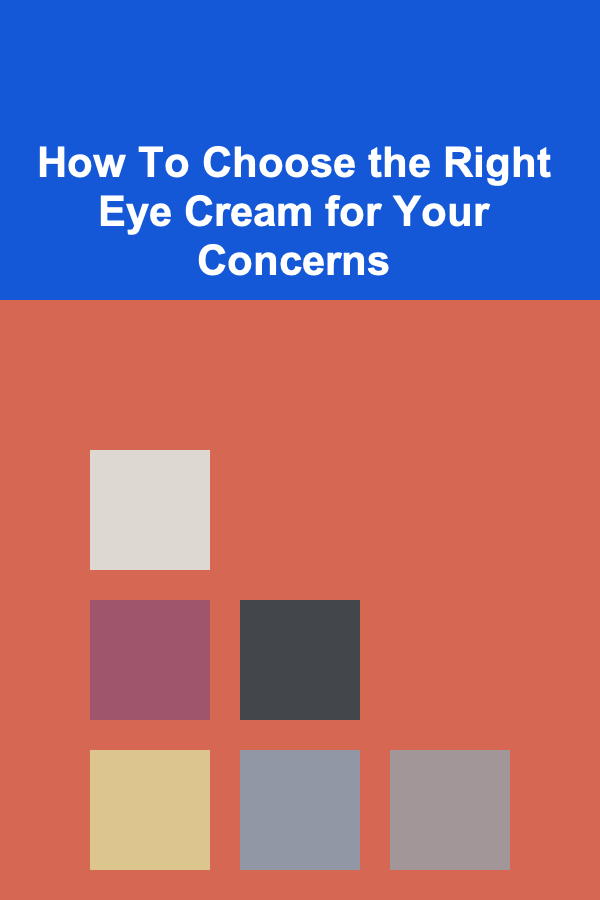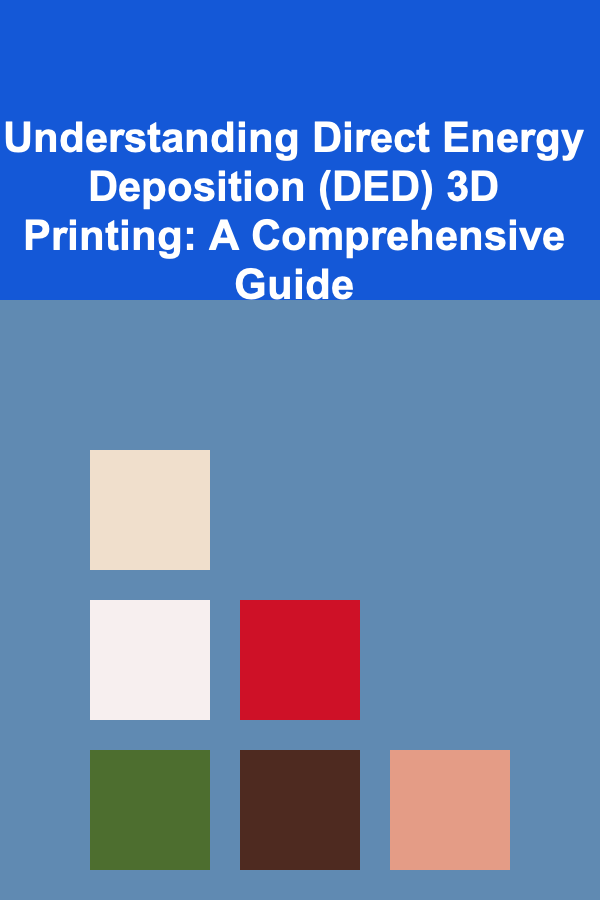
How To Choose the Right Layer Height for Quality Prints
ebook include PDF & Audio bundle (Micro Guide)
$12.99$6.99
Limited Time Offer! Order within the next:

Choosing the right layer height for 3D printing is one of the most critical decisions that will impact the quality, resolution, and performance of your prints. Whether you're a beginner or an experienced 3D printing enthusiast, understanding the relationship between layer height and print quality is essential for achieving optimal results. This article explores the intricacies of selecting the right layer height, explaining how it influences your print's appearance, strength, and overall functionality.
What is Layer Height?
Layer height refers to the thickness of each individual layer of filament laid down by the 3D printer during the printing process. The layer height is measured in millimeters (mm) and determines how finely the printer can create the model. The smaller the layer height, the finer the detail and the smoother the finish of the print. On the other hand, larger layer heights can result in faster prints with rougher surfaces.
How Does Layer Height Affect the Print?
Layer height affects several key factors in 3D printing, including:
- Print Time: A smaller layer height means that the printer will need to lay down more layers to complete the print, which increases the total print time. Conversely, larger layers reduce the print time by requiring fewer layers to fill the same amount of space.
- Surface Quality: Smaller layers tend to result in smoother surfaces, as the printer's nozzle makes finer passes. Larger layers, on the other hand, often result in visible layer lines and a rougher surface finish.
- Strength and Durability: The strength of a 3D print is influenced by the layer bonding and the overall resolution. Smaller layer heights allow for better layer adhesion, which can lead to stronger prints. However, the overall design, infill pattern, and material also play crucial roles in print strength.
- Resolution and Detail: A smaller layer height allows for finer details to be captured in the print, which is especially important for highly detailed or intricate designs. Larger layer heights might lose some of the finer details, making them suitable for basic or prototype prints.
- Printer Calibration: The ideal layer height often depends on your printer's capabilities and the nozzle size. Understanding the limitations of your 3D printer, such as maximum resolution and the size of the nozzle, is important when choosing a layer height.
The Role of Nozzle Size in Layer Height Selection
The nozzle size plays a crucial role in determining the optimal layer height. Most 3D printers come with standard nozzle sizes such as 0.4mm, but nozzles can vary in diameter, ranging from 0.2mm to 1mm or more.
- Nozzle size and layer height relationship: The general rule of thumb is that your layer height should be between 25% and 75% of the nozzle diameter. For example, if you're using a 0.4mm nozzle, the ideal layer height range would be between 0.1mm and 0.3mm.
- Nozzle capacity: Using a nozzle that is too small with a very fine layer height can result in clogs or under-extrusion, while using a large nozzle with a very large layer height can result in prints that lack fine detail.
Different Layer Heights for Different Applications
The layer height you choose will depend on your specific application. Let's break it down by use cases:
1. High-Detail Prints
For applications that require high detail, such as figurines, miniatures, and intricate parts, a smaller layer height is essential. Here, you would typically choose a layer height around 0.1mm or 0.2mm, depending on your nozzle size.
- Advantages: This results in a smoother, more refined finish with greater accuracy in the replication of fine details. Prints will appear almost seamless, with minimal visible layer lines.
- Disadvantages: The print time can increase significantly, which may be a downside for large prints.
2. Functional Parts
Functional parts that require strength and durability, such as mechanical components, are often printed at a medium layer height of around 0.2mm to 0.3mm. This layer height offers a balance between quality and strength.
- Advantages: This range allows for a good combination of strength and print speed. The prints are durable, and the layer lines are not overly visible.
- Disadvantages: While this layer height provides decent detail, it might not capture intricate designs as well as smaller layer heights.
3. Rapid Prototyping
When time is a constraint and the goal is to quickly prototype a model, larger layer heights of around 0.3mm to 0.4mm (or even higher) are commonly used. These layer heights speed up the printing process and reduce the overall time spent.
- Advantages: Rapid prototyping with a larger layer height allows for quicker prints, especially for non-detailed models or those just used to test fit and functionality.
- Disadvantages: The trade-off is a reduction in detail and a rougher surface finish. The resulting prints might require additional post-processing to smooth out the layer lines.
4. Large Prints
For large prints, using a higher layer height can drastically reduce print time without a significant compromise in quality. Layer heights of around 0.3mm to 0.4mm are common for larger objects that don't require extreme detail but need to be printed quickly.
- Advantages: Larger prints benefit from quicker build times, making them ideal for creating large objects like vases, sculptures, or architectural models.
- Disadvantages: Larger layer heights can result in less accuracy in the finer details, and larger layer lines may be visible.
How to Choose the Right Layer Height Based on Printer and Material
Printer Capabilities
The capabilities of your 3D printer will directly influence the maximum and minimum layer height you can use. Here are some considerations:
- Print resolution: Some 3D printers have higher print resolutions, which means they can handle smaller layer heights. If you have a high-resolution printer, you might be able to print with layer heights as low as 0.05mm.
- Maximum print speed: Some printers are capable of printing faster with larger layer heights. However, faster printing speeds may lead to lower quality, particularly if your printer is not well-calibrated or optimized for speed.
Material Properties
The type of filament you use also plays a role in the choice of layer height. For example:
- PLA: PLA is easy to work with and produces great results with a wide range of layer heights. A layer height of around 0.2mm is typically ideal for this material.
- ABS: ABS is a more challenging material to print with due to its tendency to warp. A layer height of 0.2mm to 0.3mm works well to ensure proper adhesion while minimizing the risk of warping.
- TPU (Flexible Filament): For flexible filaments like TPU, it's often best to print with a slightly larger layer height (around 0.2mm to 0.3mm) to allow for better flexibility and durability.
- PETG: PETG has excellent layer bonding characteristics, so you can use a wider range of layer heights. However, a layer height of 0.2mm to 0.3mm is ideal for most prints made from PETG.
How to Fine-Tune Layer Height for Your Needs
While the general guidelines provide a good starting point, fine-tuning the layer height to meet your needs will require some experimentation. Here are a few tips to help you get the most out of your 3D printer:
1. Test Print for Each Layer Height
Start by printing a small test model at different layer heights to see how the results compare. This allows you to visually assess the differences in surface finish, detail, and strength.
2. Consider Layer Bonding
The thinner the layer height, the better the bond between layers. If you are printing a functional part, it's essential to ensure that the layers adhere well to each other for maximum strength. Try using different layer heights and print a test object that will reveal potential weak points.
3. Post-Processing Considerations
Sometimes, the right layer height might not give you the perfect print out of the printer. Post-processing methods such as sanding, painting, or smoothing can help improve the surface quality, especially when printing with larger layer heights.
Conclusion
Choosing the right layer height for 3D printing is a balancing act that requires careful consideration of your project's needs, the capabilities of your printer, and the properties of the material you're using. Smaller layer heights provide finer detail and smoother surfaces, but they take longer to print. Larger layer heights can speed up printing and reduce time, but may sacrifice detail and surface finish.
By understanding the factors at play---such as print resolution, material properties, and the trade-offs between quality and speed---you can make an informed decision on the optimal layer height for each project. Experimenting with different settings and fine-tuning your approach will help you achieve the perfect balance between speed, strength, and visual appeal for your prints.

Developing AI-Powered Apps for Recurring Revenue Using Deep Learning
Read More
How to Decorate for Thanksgiving with Elegant and Simple Touches
Read More
How To Choose the Right Eye Cream for Your Concerns
Read More
How to Choose a Banking Solution for Global Travel
Read More
Understanding Direct Energy Deposition (DED) 3D Printing: A Comprehensive Guide
Read More
How to Track Client Entertainment Expenses Effectively
Read MoreOther Products

Developing AI-Powered Apps for Recurring Revenue Using Deep Learning
Read More
How to Decorate for Thanksgiving with Elegant and Simple Touches
Read More
How To Choose the Right Eye Cream for Your Concerns
Read More
How to Choose a Banking Solution for Global Travel
Read More
Understanding Direct Energy Deposition (DED) 3D Printing: A Comprehensive Guide
Read More